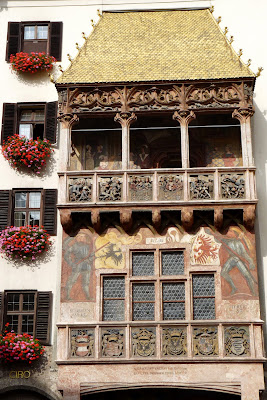As this was a literal trip, this will be more of a travelogue than a search for the perfect hotel. Our accommodations were part of a group, and the hotel venue was pre-arranged. So I will provide a tour of Hotel Rieser, where we stayed in the lakeside village of Pertisau (it was lovely!) and some of the highlights of the area, including places of interest in Innsbruck. (Since this is based on actual travel, photos will be by ScheckTrek Photography unless otherwise noted.)
Pertisau and Hotel Rieser
Front of the hotel, with mountain backdrop and typical window boxes overflowing with flowers. They’ve got to be keeping Miracle-Gro in business!
Pool and adjacent hotel property
www.hotel-rieser.com
I loved the rugs throughout the hotel.
Our room, #222
Those walls certainly looked like Venetian plaster to me.
The view from south-facing room #222. The little church played Ave Maria at noon and 6:00 p.m. every day. They had a good sound system!
Partial lake view from our balcony
Closer view of the lake
Indoor pools don’t get much better than this. And can you just imagine what it’s like to be inside here, all warm and cozy, when snow is covering those mountains?
The opening in the glass wall allows for indoor/outdoor swimming.
I almost included a photo of the sauna, but decided against it. Suffice it to say that they don’t dress for the sauna!
Building that houses the swimming pool and second-floor indoor/outdoor sundeck, as seen from pond on the hotel’s property.
One of the charming dining rooms, where every night we were served 5-course dinners.
One night we went to a mountain hut for an evening of music and hot mulled wine.
By happy coincidence, we were in Pertisau on one of the two most important days of the year: the day the cows are brought down from the mountains before winter. (The other most important day is, no surprise, the day they go up to the mountains in the spring.) All my life I’ve heard about “[this or that] till the cows come home.” So here’s the proof that it has now happened!
I’m pretty sure the spectators enjoyed the parade more than the cows did, poor old gals.
INNSBRUCK
Staying in Pertisau puts one within easy striking distance of beautiful Innsbruck, city of the Golden Roof and, as it turns out, a golden lady.
The Golden Roof
The Golden Roof (Goldenes Dachl) -- probably the most recognized tourist attraction of Innsbruck -- is a Late Gothic window and balcony, topped with a roof of 2,657 gilded copper tiles. Built in 1494-96 as a royal box for watching tournaments on the square below, it was commissioned by Archduke Friedrich IV for Maximilian I, Emperor of the Holy Roman Empire. According to Wikipedia, it was to commemorate Maximilian I’s marriage (his 2nd) to Bianca Maria Sforza. Not wanting to alienate allies gained by his first marriage, to Maria of Burgundy, the Emperor had images of himself, between the two women, painted on the balcony. The lower balustrade is decorated with the coat of arms.
But inquiring minds want to know: why was there a row of rats lining the roof? Do you see them, running along above where the columns end?
Heibling Haus
Built in the 15th century, the Helbling Haus was originally a Gothic townhouse. In the early 1700s the facade decorated with Late Baroque stucco work, including cherubs, acanthus leaves and shells. When seen in person, it looks like porcelain.
Unbelievable wedding-cake architecture
How much time and money went into this???
Cathedral of St. James
Speaking of which, how much time and money went into building the Cathedral of St. James (Dom zu St. Jakob)? Built between 1717 and 1724, it has an extravagant Baroque interior.
Mausoleum for Maximilian I
One enters the mausoleum for Maximilian I, located in the Imperial Court Church (Hofkirche), through the Tyrolean Folk Art Museum (Tiroler Volksmuseum).
Though a lavish tribute to the Emperor who turned the Habsburgs into one of Europe’s most notable dynasties, it is, alas, an empty tomb (he’s buried near Vienna). However, the Hofkirche, built in his honor in the mid-1500s by his grandson, Ferdinand I, is not to be missed on a trip to Innsbruck. The empty tomb is silently guarded by 28 larger-than-life bronze statues (ancestors, relatives, and heros, including King Arthur). They are arguably the most important specimen of German Renaissance sculpture. I hope the close-up shots will help to convey their level of detail.
You can’t believe the detail in every single statue.
The black marble sarcophagus is surrounded by 24 white marble reliefs, each of which depicts accomplishments during the reign of Maximilian I. Encasing the tomb is an ornate grill with gold-leaf(?) accents.
In and Around Innsbruck
All too soon, it was time for us to leave as well.


.jpg)











.jpg)
.jpg)




















No comments:
Post a Comment